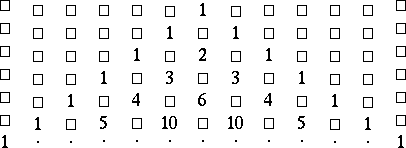Pascal triangle
A table of the binomial coefficients. In this table, there are 1's at the lateral sides of an equilateral triangle and each of the remaining numbers is the sum of the two numbers above it to the left and right:
 |
In the row numbered  there appear the coefficients of the expansion of the binomial
there appear the coefficients of the expansion of the binomial  . The triangular table presented by B. Pascal in his Treatise on an arithmetical triangle (1654) differs from the one described above by a rotation through
. The triangular table presented by B. Pascal in his Treatise on an arithmetical triangle (1654) differs from the one described above by a rotation through  . Tables for the representation of the binomial coefficients were known even earlier.
. Tables for the representation of the binomial coefficients were known even earlier.
References
| [1] | V.A. Uspenskii, "Pascal's triangle" , Moscow (1979) (In Russian) |
| [2] | , The history of mathematics from Antiquity to the beginning of the XIX-th century , 2 , Moscow (1970) (In Russian) |
Comments
The binomial coefficients triangle (arithmetical triangle) was, e.g., known to N. Tartaglia, M. Stifel and S. Stevin long before Pascal. Still earlier it appeared in the Chinese mathematical literature (Chu Shih-Chieh, "precious mirror" , Yang Hui, before 1300) and in the Arabian literature (Al-Kashi, early 1400's). In the Western literature the triangle occurs printed on the title page of Stifel's Arithmetica integra, published in 1544, almost a century before the birth of Pascal.
References
| [a1] | C.F. Boyer, "A history of mathematics" , Wiley (1968) |
| [a2] | M. Kline, "Mathematical thought from ancient to modern times" , Oxford Univ. Press (1972) |
Pascal triangle. Encyclopedia of Mathematics. URL: http://encyclopediaofmath.org/index.php?title=Pascal_triangle&oldid=48141